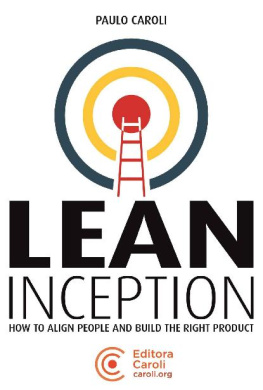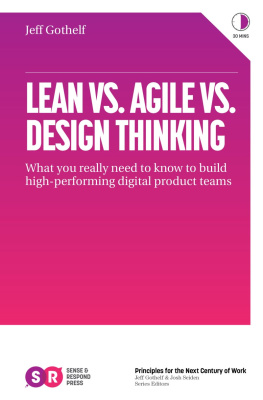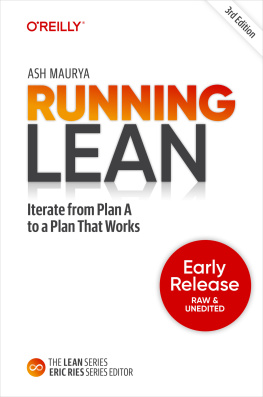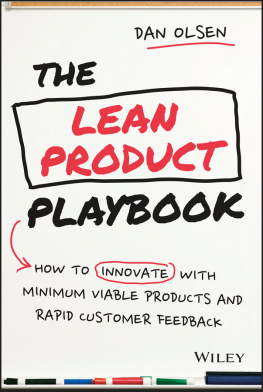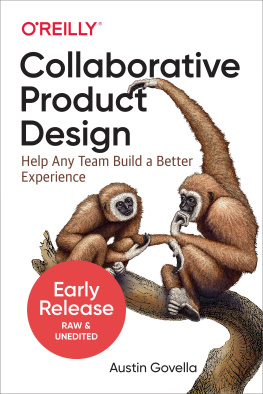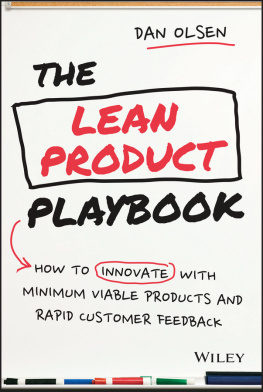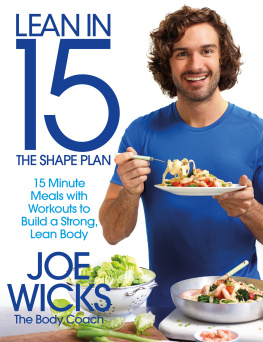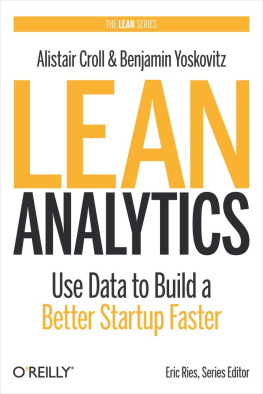Paulo Caroli - Lean Inception: How to Align People and Build the Right Product
Here you can read online Paulo Caroli - Lean Inception: How to Align People and Build the Right Product full text of the book (entire story) in english for free. Download pdf and epub, get meaning, cover and reviews about this ebook. City: São Paulo, year: 2018, publisher: Editora Caroli, genre: Computer. Description of the work, (preface) as well as reviews are available. Best literature library LitArk.com created for fans of good reading and offers a wide selection of genres:
Romance novel
Science fiction
Adventure
Detective
Science
History
Home and family
Prose
Art
Politics
Computer
Non-fiction
Religion
Business
Children
Humor
Choose a favorite category and find really read worthwhile books. Enjoy immersion in the world of imagination, feel the emotions of the characters or learn something new for yourself, make an fascinating discovery.
- Book:Lean Inception: How to Align People and Build the Right Product
- Author:
- Publisher:Editora Caroli
- Genre:
- Year:2018
- City:São Paulo
- Rating:5 / 5
- Favourites:Add to favourites
- Your mark:
- 100
- 1
- 2
- 3
- 4
- 5
Lean Inception: How to Align People and Build the Right Product: summary, description and annotation
We offer to read an annotation, description, summary or preface (depends on what the author of the book "Lean Inception: How to Align People and Build the Right Product" wrote himself). If you haven't found the necessary information about the book — write in the comments, we will try to find it.
Paulo Caroli: author's other books
Who wrote Lean Inception: How to Align People and Build the Right Product? Find out the surname, the name of the author of the book and a list of all author's works by series.
Lean Inception: How to Align People and Build the Right Product — read online for free the complete book (whole text) full work
Below is the text of the book, divided by pages. System saving the place of the last page read, allows you to conveniently read the book "Lean Inception: How to Align People and Build the Right Product" online for free, without having to search again every time where you left off. Put a bookmark, and you can go to the page where you finished reading at any time.
Font size:
Interval:
Bookmark:
The naive view of agile software development is that everyone just dives in andstarts writing code without spending any time at the beginning working out what to do.
That view, although as erroneous as it is simplistic, is based on a genuine shiftin thinking. Prior to Agiles rise, serious software people advised long periodsof requirements gathering and architecture, where a five-year project mightspend a year or two before any code was written, let alone released intoproduction. The agile world has discarded such long periods of up-frontanalysis, but we still recognize that there is value in setting out with aninitial sense of direction. The challenge is figuring out how we can do this quicklyand efficiently, while remembering that nothing teaches us what we want more than an incomplete product thats released and in use. So, we need to balance setting direction with the knowledge that such up-front thinking is our most tentative.
In ThoughtWorks, our response has been a process called an inception. We gathertogether a good sample of the people who will be affected by the product and have an intensive session to set an initial direction, using a series of exercisesfocusing on collaboration and the capture of broad goals. We dont attempt adetailed specification, as that is exactly the kind of thing that becomes out ofdate as soon as code hits production. But we do want to understand what kind ofoutcomes we are hoping for, the features that we think will drive theseoutcomes, and how to assess the effectiveness of our product.
With The Lean Inception, Paulo has captured his experience in running theseinceptions over the last decade. In particular its focused on his work toboil the inception down to its essence, concentrating the activity on a single,if very intensive, week of work. Paulo shares how he makes thiswork, through writing a product vision, capturing personas, understanding theuser journeys, and developing high-level features. The result isnt a detailedplan of work, which we find quickly rots into irrelevance. It is a guiding setof goals to set us off in the right direction. It doesnt plan out a finalproduct, with all the features that our users will need, instead it focuses onan initial product that we can release and learn from - the Minimum ViableProduct. This product acts as the starting point for evolving a richer and morecapable product, and again we can use lean inceptions to help with each step ofthis evolution.
In this book, youll find Paulos experience harvested from six years of runningthese lean inceptions. Theres a timetable for the weeks activity, detailsof the exercises to do, and tips to help the teams learn from the release ofthe Minimum Viable Product. The efforts of the week are summarized in an MVPCanvas which acts as simple output and summary of the work. Armed with Paulosexperience, you can practice this technique and evolve it to suit your circumstances.
Martin Fowler, Chief Scientist, ThoughtWorks. martinfowler.com
Thank you, ThoughtWorks and ThoughtWorkers for inspiring me and using my Lean Inception activities. I truly believe this amazing content emerged from a very specific context which you are part of. My special thanks to ThoughtWorks Brazil, my home country and the cradle of this work.
Thank you to the ones who shared their knowledge about inception workshops and made this work possible. My special thanks to Jeff Patton and Jonathan Rasmusson, with whom I have the pleasure and privilege to learn from.
Thanks, everyone that read, used and shared feedback on the Lean Inception. This content evolved due to the great feedback and the shared experiences. I only realized this was something special once I heard about its success when applied by other facilitators.
Thanks to Martin Fowler for coaching me and asking for this content in English. I really appreciate your support and incentive when sharing important practices with our greater community, such as the Lean Inception.
Thanks to Patrick Sarnacke for the detailed review on this book contents. I really appreciate your inputs since 2008, the year you started learning and improving the Brazilian-English.
Thanks to my family for the love and support while I keep reading and writing, in the pursuit of learning and sharing. My special thanks to Joo Caroli. I can still remember my first trip after you were born. Ive always loved facilitating inceptions, but I love you more and could not stay away for more than a few days. I had to make them lean in order to come back faster. You definitely inspired me!
From the beginning to the end! This is a short and practical book. As the title says: Lean. Ergo, you must read it all, from the beginning to the end.
The book is structured in four parts:Building the right product, Preparing for the workshop, Running the Lean Inception, and Appendix.
To start, I tell my story with inceptions and why I created the Lean Inception concept. The book is based on the concept of MVP, short for Minimum Viable Product. The chapter named after it presents the concept and its history, as well as my view on MVP and the evolution of lean products.
This section explains in detail the collaborative workshop format that will help you to understand, align and plan the lean product to be built. Maybe its the beginning of an agile project in a big corporation, or the alignment on what to build in a small start-up. The collaborative and dynamic style of Lean Inception is the chefs secret of this recipe.
Lean Inception is a recipe, a sequence of collaborative and dynamic activities that will build the MVP canvas, a visual representation of the lean products evolution and creation plan. Every step of this recipe is detailed matching the order of chapters, starting at chapter 4 Write the Product Vision, and ending at chapter 12 Build the MVP Canvas.
A book named Lean obliges the author to write an appendix. I consider the whole content of this book essential. However, here in the appendix you can find what was added with time, based on readers feedback.
The appendix A brings you a real example of understanding and planning of a lean product from the Lean Inception recipe, done in a super-lean inception: made in only six hours! Some readers have told me that first they read this appendix and then they read the book from the start.
The appendices B, C, D and E provide, respectively, the glossary of the terms in the book, a classification about the levels of competence of the facilitator, a detailing about the burn-up agenda, and some ice-breaker activities.
Good reading and welcome to the Lean Inceptions facilitators group.
Disclaimer: On the book you will find many photos from real Lean Inceptions; the good thing, these photos give you a good hint about the activities in action, with people and handwritten text on colored post-it. The bad thing, they are hard to read, and dont print as nice as designed graphics. I used both, real photos and designed graphics, for illustrating the Lean Inception activities.
Agile projects emphasize the early and continuous delivery of a valuable product, whose value comes from business objectives and the needs of customers. Lean StartUp product creation helps this by promoting the incremental release of an MVP (Minimum Viable Product) a simple version of a product that is given to users in order to validate the key business assumptions.
Font size:
Interval:
Bookmark:
Similar books «Lean Inception: How to Align People and Build the Right Product»
Look at similar books to Lean Inception: How to Align People and Build the Right Product. We have selected literature similar in name and meaning in the hope of providing readers with more options to find new, interesting, not yet read works.
Discussion, reviews of the book Lean Inception: How to Align People and Build the Right Product and just readers' own opinions. Leave your comments, write what you think about the work, its meaning or the main characters. Specify what exactly you liked and what you didn't like, and why you think so.

